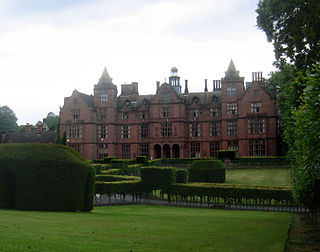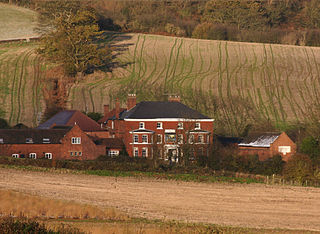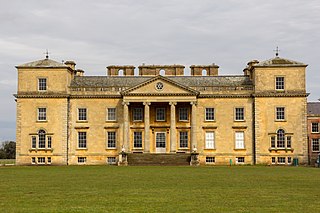
Abberley is a village and civil parish in north west Worcestershire, England.

Witley Court, in Great Witley, Worcestershire, England, is a ruined Italianate mansion. Built for the Foleys in the seventeenth century on the site of a former manor house, it was enormously expanded in the early nineteenth century by the architect John Nash for Thomas Foley, 3rd Baron Foley. The estate was later sold to the Earls of Dudley, who undertook a second massive reconstruction in the mid-19th century, employing the architect Samuel Daukes to create one of the great palaces of Victorian and Edwardian England.

Hewell Grange is a former country house in Tardebigge, Worcestershire, England. "One of the most important late 19th century country houses in England", the mansion was built between 1884 and 1891 by George Frederick Bodley and Thomas Garner for Robert Windsor-Clive, later first Earl of Plymouth. Constructed in the Jacobethan style, it was "perhaps the last Victorian prodigy house". After the Second World War, the third earl sold the Hewell estate to the Crown and it was redeveloped as a prison. The mansion was used to house young offenders, and later low-risk prisoners, while adult prisons were built in the grounds. The site was subsequently consolidated as HM Prison Hewell. In 2019, the Ministry of Justice announced the closure of the Category D open prison housed in Hewell Grange, after a highly critical report by Her Majesty's Inspectorate of Prisons.

William Walsh of Abberley Hall, Worcestershire was an English poet and critic and a Whig politician who sat in the English and British House of Commons from 1698 to 1708.

Great Witley is a village and civil parish in the Malvern Hills District in the northwest of the county of Worcestershire, England. It is situated around ten miles to the north west of the city of Worcester. The parish had a population of 743 in 2021.

Capesthorne Hall is a country house near the village of Siddington, Cheshire, England. The house and its private chapel were built in the early 18th century, replacing an earlier hall and chapel nearby. They were built to Neoclassical designs by William Smith and (probably) his son Francis. Later in the 18th century, the house was extended by the addition of an orangery and a drawing room. In the 1830s the house was remodelled by Edward Blore; the work included the addition of an extension and a frontage in Jacobean style, and joining the central block to the service wings. In about 1837 the orangery was replaced by a large conservatory designed by Joseph Paxton. In 1861 the main part of the house was virtually destroyed by fire. It was rebuilt by Anthony Salvin, who generally followed Blore's designs but made modifications to the front, rebuilt the back of the house in Jacobean style, and altered the interior. There were further alterations later in the 19th century, including remodelling of the Saloon. During the Second World War the hall was used by the Red Cross, but subsequent deterioration prompted a restoration.

Madresfield Court is a country house in Malvern, Worcestershire, England. The home of the Lygon family for nearly six centuries, it has never been sold and has passed only by inheritance since the 12th century; a line of unbroken family ownership reputedly exceeded in length in England only by homes owned by the British Royal Family. The present building is largely a Victorian reconstruction, although the origins of the present house are from the 16th century, and the site has been occupied since Anglo-Saxon times. The novelist Evelyn Waugh was a frequent visitor to the house and based the family of Marchmain, who are central to his novel Brideshead Revisited, on the Lygons. Surrounded by a moat, the Court is a Grade I listed building.

Elmley Castle is a village and civil parish in Worcestershire, in England, United Kingdom. It is located on the north side of Bredon Hill 3 miles south-east of Pershore in the local government district of Wychavon.
Samuel Whitfield Daukes (1811–1880) was an English architect, based in Gloucester and London.

Croome Court is a mid-18th-century Neo-Palladian mansion surrounded by extensive landscaped parkland at Croome D'Abitot, near Upton-upon-Severn in south Worcestershire, England. The mansion and park were designed by Lancelot "Capability" Brown for the 6th Earl of Coventry, and they were Brown's first landscape design and first major architectural project. Some of the mansion's rooms were designed by Robert Adam. St Mary Magdalene's Church, Croome D'Abitot that sits within the grounds of the park is now owned and cared for by the Churches Conservation Trust.
This is a list of sheriffs and since 1998 high sheriffs of Worcestershire.

Hindlip Hall is a stately home in Hindlip, Worcestershire, England. The first major hall was built before 1575, and it played a significant role in both the Babington and the Gunpowder plots, where it hid four people in priest holes. It was Humphrey Littleton who told the authorities that Edward Oldcorne was hiding here after he had been heard saying Mass at Hindlip Hall. Four people were executed and the owner at that time barely escaped execution himself due to the intercession of Lord Monteagle.
Abberley Hall School was a coeducational preparatory day and boarding school with about 160 pupils. It was located between Worcester and Tenbury, near the village of Abberley, Worcestershire, England.
Walter Walsh was a courtier and Groom of the Privy Chamber at the court of Henry VIII of England. In November 1530, Cardinal Wolsey surrendered the Great Seal to Walsh and Henry Percy, 6th Earl of Northumberland, when they arrived to remove it from him.

Bredon School, formerly Pull Court, is a private school in Bushley, Worcestershire, England. The house was built for the Reverend Canon E. C. Dowdeswell by Edward Blore between 1831 and 1839. The site is much older and Blore's house replaced an earlier mansion. The Dowdeswells had been prominent in local and national politics since the 18th century, with many serving as members of Parliament. The family sold the house in 1934 to the parents of Richard Seaman, a prominent pre-war racing driver, who lived there until his death in a crash in the 1939 Belgian Grand Prix. In 1962, the court became a school, Bredon School, founded by Lt-Col Tony Sharp and Hugh Jarrett, for the education of boys who had failed the Common Entrance Examination. It remains a specialist school with a focus on educating children with specific learning difficulties, such as dyslexia and dyspraxia.

Abberley Clock Tower is a prominent, distinctive clock tower in Abberley, Worcestershire, England. Built by James Piers St Aubyn around 1883 for Abberley Hall it is now part of Abberley Hall School. It is a Grade II* listed building and claimed to be visible from six counties.

Astley Hall is a country house in Astley near Stourport-on-Severn, Worcestershire, England. The hall was the home of Prime Minister Stanley Baldwin from 1902 until his death there in 1947. It is now a nursing home.

The Elms Hotel in Abberley, Worcestershire is a building of historical significance and is Grade II listed on the English Heritage Register. It was built in 1710 by the architect Thomas White (1674-1748) of Worcester who was a pupil of Sir Christopher Wren. It was the home of several notable families over the next two centuries and is now a hotel.















